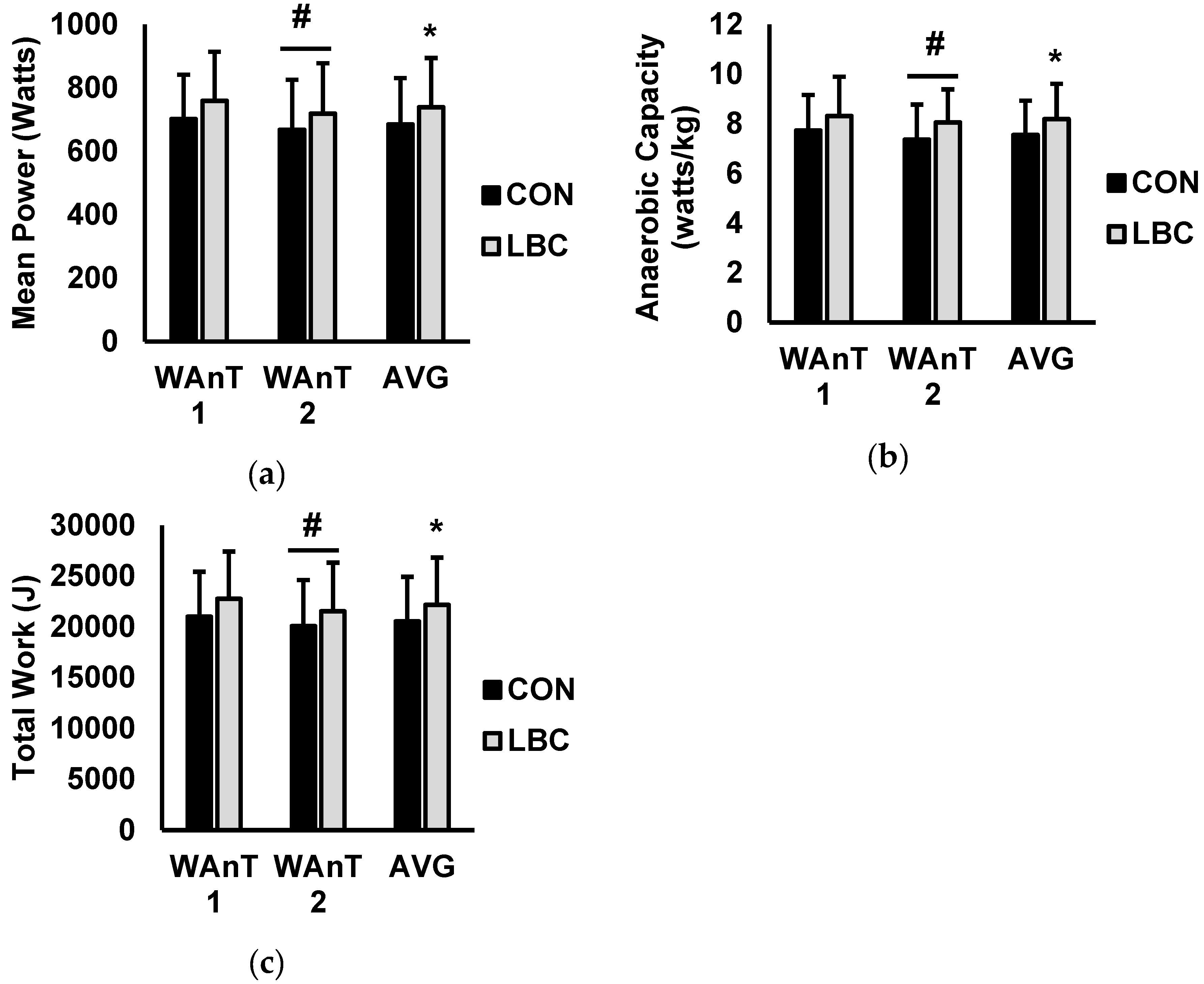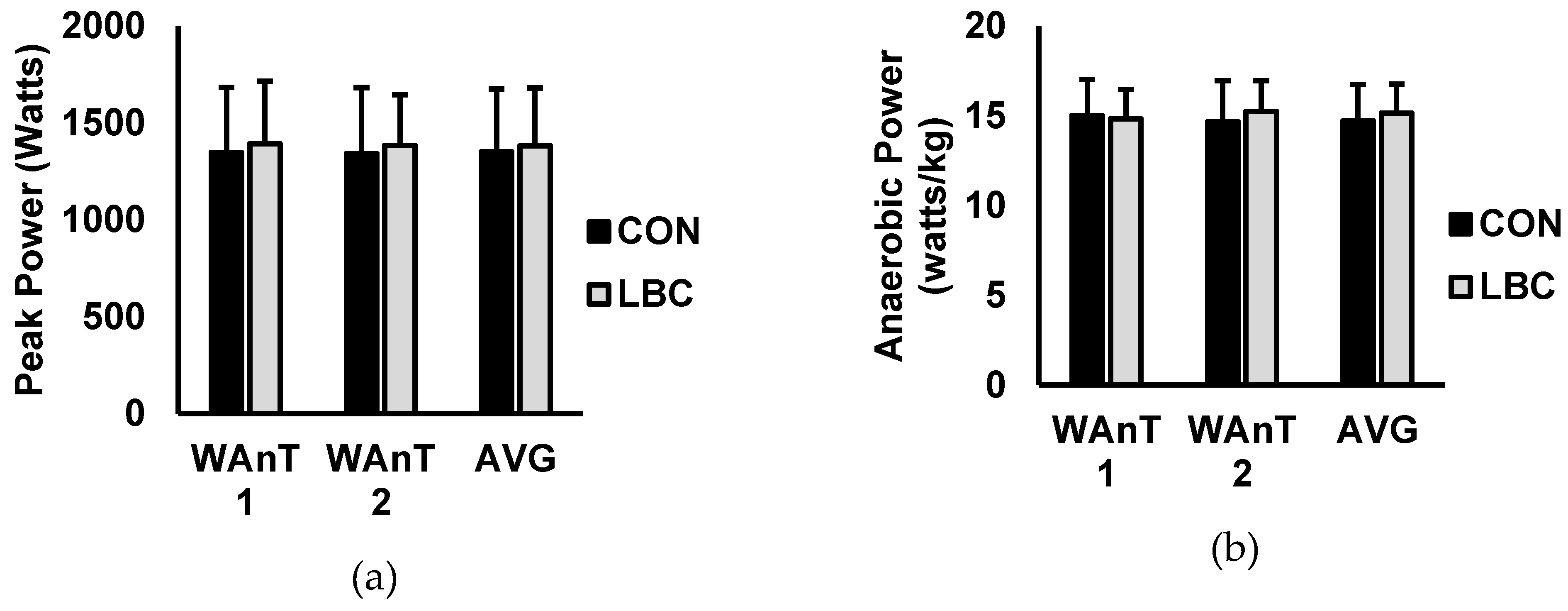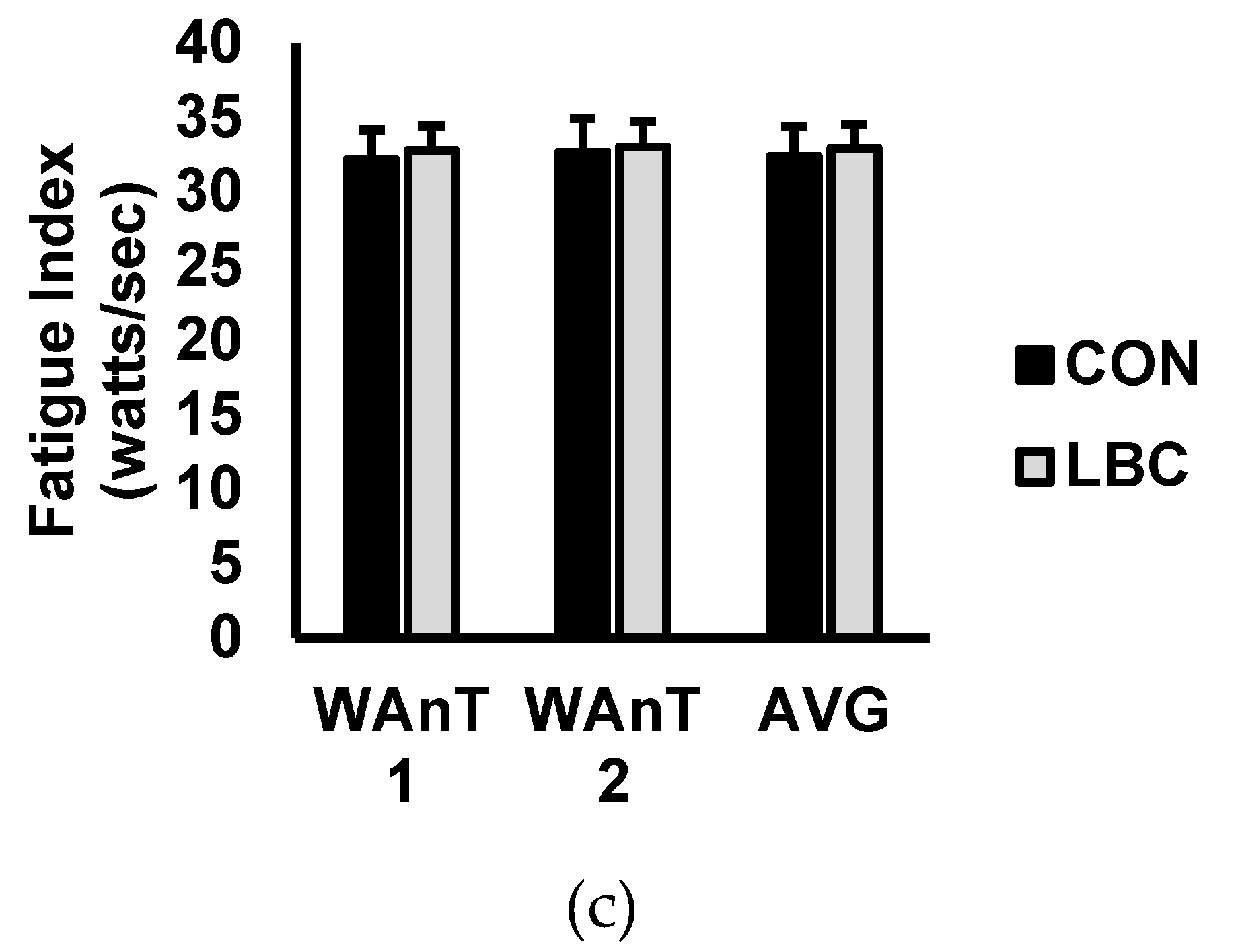The Effect of Wearing a Lower Body Compression Garment on Anaerobic Exercise Performance in Division I NCAA Basketball Players
Abstract
:1. Introduction
2. Materials and Methods
2.1. Study Design
2.2. Subjects
2.3. Procedures
2.4. Statistical Analysis
3. Results
4. Discussion
Author Contributions
Funding
Acknowledgments
Conflicts of Interest
References
- Ahmaidi, S.; Granier, P.; Taoutaou, Z.; Mercier, J.; Dubouchaud, H.; Prefaut, C. Effects of active recovery on plasma lactate and anaerobic power following repeated intensive exercise. Med. Sci. Sports Exerc. 1996, 28, 450–456. [Google Scholar] [CrossRef]
- Dupont, G.; Moalla, W.; Guinhouya, C.; Ahmaidi, S.; Berthoin, S. Passive versus active recovery during high-intensity intermittent exercises. Med. Sci. Sports Exerc. 2004, 36, 302–308. [Google Scholar] [CrossRef]
- Ballmann, C.G.; Maze, S.B.; Wells, A.C.; Marshall, M.M.; Rogers, R.R. Effects of short-term Rhodiola Rosea (Golden Root Extract) supplementation on anaerobic exercise performance. J. Sports Sci. 2019, 37, 998–1003. [Google Scholar] [CrossRef]
- Montgomery, P.G.; Pyne, D.B.; Hopkins, W.G.; Dorman, J.C.; Cook, K.; Minahan, C.L. The effect of recovery strategies on physical performance and cumulative fatigue in competitive basketball. J. Sports Sci. 2008, 26, 1135–1145. [Google Scholar] [CrossRef]
- Morton, R.H. Contrast water immersion hastens plasma lactate decrease after intense anaerobic exercise. J. Sci. Med. Sport 2007, 10, 467–470. [Google Scholar] [CrossRef]
- MacRae, B.A.; Cotter, J.D.; Laing, R.M. Compression garments and exercise: Garment considerations, physiology and performance. Sports Med. 2011, 41, 815–843. [Google Scholar] [CrossRef]
- De Glanville, K.M.; Hamlin, M.J. Positive effect of lower body compression garments on subsequent 40-kM cycling time trial performance. J. Strength Cond. Res. 2012, 26, 480–486. [Google Scholar] [CrossRef]
- Jakeman, J.R.; Byrne, C.; Eston, R.G. Lower limb compression garment improves recovery from exercise-induced muscle damage in young, active females. Eur. J. Appl. Physiol. 2010, 109, 1137–1144. [Google Scholar] [CrossRef]
- Duffield, R.; Cannon, J.; King, M. The effects of compression garments on recovery of muscle performance following high-intensity sprint and plyometric exercise. J. Sci. Med. Sport 2010, 13, 136–140. [Google Scholar] [CrossRef]
- Borràs, X.; Balius, X.; Drobnic, F.; Til, L.; Turmo, A.; Valle, J. Effects of Lower Body Compression Garment in Muscle Oscillation and Tissular Injury during Intense Exercise. In Proceedings of the ISBS—Conference Proceedings Archive, Porto, Portugal, 27 June–1 July 2011. [Google Scholar]
- Duffield, R.; Edge, J.; Merrells, R.; Hawke, E.; Barnes, M.; Simcock, D.; Gill, N. The effects of compression garments on intermittent exercise performance and recovery on consecutive days. Int. J. Sports Physiol. Perform. 2008, 3, 454–468. [Google Scholar] [CrossRef]
- Liu, R.; Lao, T.T.; Kwok, Y.L.; Li, Y.; Ying, M.T. Effects of graduated compression stockings with different pressure profiles on lower-limb venous structures and haemodynamics. Adv. Ther. 2008, 25, 465–478. [Google Scholar] [CrossRef]
- Menetrier, A.; Mourot, L.; Bouhaddi, M.; Regnard, J.; Tordi, N. Compression sleeves increase tissue oxygen saturation but not running performance. Int. J. Sports Med. 2011, 32, 864–868. [Google Scholar] [CrossRef]
- Kemmler, W.; von Stengel, S.; Kockritz, C.; Mayhew, J.; Wassermann, A.; Zapf, J. Effect of compression stockings on running performance in men runners. J. Strength Cond. Res. 2009, 23, 101–105. [Google Scholar] [CrossRef]
- Scanlan, A.T.; Dascombe, B.J.; Reaburn, P.R.; Osborne, M. The effects of wearing lower-body compression garments during endurance cycling. Int. J. Sports Physiol. Perform. 2008, 3, 424–438. [Google Scholar] [CrossRef]
- Driller, M.W.; Halson, S.L. The effects of wearing lower body compression garments during a cycling performance test. Int. J. Sports Physiol. Perform. 2013, 8, 300–306. [Google Scholar] [CrossRef]
- Dascombe, B.J.; Hoare, T.K.; Sear, J.A.; Reaburn, P.R.; Scanlan, A.T. The effects of wearing undersized lower-body compression garments on endurance running performance. Int. J. Sports Physiol. Perform. 2011, 6, 160–173. [Google Scholar] [CrossRef]
- Kraemer, W.J.; Bush, J.A.; Bauer, J.A.; Tripleft-McBride, N.; Paxton, N.J.; Clemson, A.; Koziris, L.P.; Mangino, L.C.; Fry, A.C.; Newton, R.U. Influence of compression garments on vertical jump performance in NCAA Division I volleyball players. J. Strength Cond. Res. 1996, 10, 180–183. [Google Scholar]
- Faulkner, J.A.; Gleadon, D.; McLaren, J.; Jakeman, J.R. Effect of lower-limb compression clothing on 400-m sprint performance. J. Strength Cond. Res. 2013, 27, 669–676. [Google Scholar] [CrossRef]
- Hamlin, M.J.; Mitchell, C.J.; Ward, F.D.; Draper, N.; Shearman, J.P.; Kimber, N.E. Effect of compression garments on short-term recovery of repeated sprint and 3-km running performance in rugby union players. J. Strength Cond. Res. 2012, 26, 2975–2982. [Google Scholar] [CrossRef]
- Janeira, M.; Maia, J. Game intensity in basketball. An interactionist view linking time-motion analysis, lactate concentration and heart rate. Coach. Sport Sci. J. 1998, 3, 26–30. [Google Scholar]
- Powers, S.K.; Howley, E.T. Exercise Physiology: Theory and Application to Fitness and Performance; McGraw-Hill Humanities/Social Sciences/Languages: New York, NY, USA, 2014. [Google Scholar]
- Zupan, M.F.; Arata, A.W.; Dawson, L.H.; Wile, A.L.; Payn, T.L.; Hannon, M.E. Wingate Anaerobic Test peak power and anaerobic capacity classifications for men and women intercollegiate athletes. J. Strength Cond. Res. 2009, 23, 2598–2604. [Google Scholar] [CrossRef]
- Cohen, J. Statistical Power Analysis for the Behavioral Sciences, 2nd ed.; Erlbaum Associates: Hillsdale, MI, USA, 1988. [Google Scholar]
- McMahon, S.; Jenkins, D. Factors affecting the rate of phosphocreatine resynthesis following intense exercise. Sports Med. 2002, 32, 761–784. [Google Scholar] [CrossRef]
- Broatch, J.R.; Bishop, D.J.; Halson, S. Lower limb sports compression garments improve muscle blood flow and exercise performance during repeated-sprint cycling. Int. J. Sports Physiol. Perform. 2018, 13, 882–890. [Google Scholar] [CrossRef]
- Lovell, D.I.; Mason, D.G.; Delphinus, E.M.; McLellan, C.P. Do compression garments enhance the active recovery process after high-intensity running? J. Strength Cond. Res. 2011, 25, 3264–3268. [Google Scholar] [CrossRef]
- Andrews, M.A.; Godt, R.E.; Nosek, T.M. Influence of physiological L(+)-lactate concentrations on contractility of skinned striated muscle fibers of rabbit. J. Appl. Physiol. (1985) 1996, 80, 2060–2065. [Google Scholar] [CrossRef]
- Berry, M.J.; McMurray, R.G. Effects of graduated compression stockings on blood lactate following an exhaustive bout of exercise. Am. J. Phys. Med. 1987, 66, 121–132. [Google Scholar] [CrossRef]
- Hoffman, J.R.; Epstein, S.; Einbinder, M.; Weinstein, Y. A comparison between the Wingate anaerobic power test to both vertical jump and line drill tests in basketball players. J. Strength Cond. Res. 2000, 14, 261–264. [Google Scholar]
- Lyons, M.; Al-Nakeeb, Y.; Nevill, A. The impact of moderate and high intensity total body fatigue on passing accuracy in expert and novice basketball players. J. Sports Sci. Med. 2006, 5, 215. [Google Scholar]
- Leite, N.M.C.; Gonçalves, B.S.V.; Sampaio, A.J.D.E.; Saiz, S.J. Effects of the playing formation and game format on heart rate, rate of perceived exertion, vertical jump, individual and collective performance indicators in youth basketball training. Int. SportMed J. 2013, 14, 127–138. [Google Scholar]
- Royal, K.A.; Farrow, D.; Mujika, I.; Halson, S.L.; Pyne, D.; Abernethy, B. The effects of fatigue on decision making and shooting skill performance in water polo players. J. Sports Sci. 2006, 24, 807–815. [Google Scholar] [CrossRef]




© 2019 by the authors. Licensee MDPI, Basel, Switzerland. This article is an open access article distributed under the terms and conditions of the Creative Commons Attribution (CC BY) license (http://creativecommons.org/licenses/by/4.0/).
Share and Cite
Ballmann, C.; Hotchkiss, H.; Marshall, M.; Rogers, R. The Effect of Wearing a Lower Body Compression Garment on Anaerobic Exercise Performance in Division I NCAA Basketball Players. Sports 2019, 7, 144. https://doi.org/10.3390/sports7060144
Ballmann C, Hotchkiss H, Marshall M, Rogers R. The Effect of Wearing a Lower Body Compression Garment on Anaerobic Exercise Performance in Division I NCAA Basketball Players. Sports. 2019; 7(6):144. https://doi.org/10.3390/sports7060144
Chicago/Turabian StyleBallmann, Christopher, Hunter Hotchkiss, Mallory Marshall, and Rebecca Rogers. 2019. "The Effect of Wearing a Lower Body Compression Garment on Anaerobic Exercise Performance in Division I NCAA Basketball Players" Sports 7, no. 6: 144. https://doi.org/10.3390/sports7060144
APA StyleBallmann, C., Hotchkiss, H., Marshall, M., & Rogers, R. (2019). The Effect of Wearing a Lower Body Compression Garment on Anaerobic Exercise Performance in Division I NCAA Basketball Players. Sports, 7(6), 144. https://doi.org/10.3390/sports7060144





